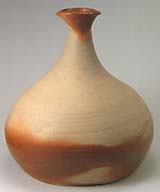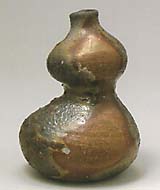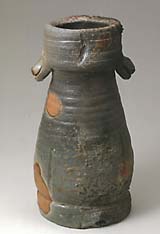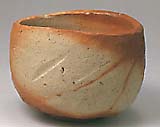|

Click here for
index to all
Yellin stories for
The Japan Times

Yellin's gallery
sells pieces from
the kilns of Japan's
finest potters
|
|
|
KANESHIGE SOZAN
The pot is mightier than the sword
By ROBERT YELLIN
for the Japan Times, August 13, 2003
|
|

A rounded "Turnip Vase"
with hidasuki markings (1988)
|
|
|

Gourd-shaped tokkuri (1974)
|
|
|

Bizen eared vase (1984)
|
|
|

Hidesuki chawan (1989)
|
|
|
All pieces by
Kaneshige Sozan
Photos courtesy
Okayama Prefectural Museum
|
|
|
|
|
As brutal as they may have been, many feudal Japanese warlords were passionate about the Way of Tea. In the midst of battle they would pause for a "tea break," appreciating the fleeting moment and simple joys of tea -- with bits of strategy tossed in.
In fact, Japan's greatest warlord, Toyotomi Hideyoshi (1537-98), was also one of its greatest art patrons. Indeed, so enamored with Tea was he, that he even declared no-combat zones around areas where special potters lived.
One such area is the small town of Bizen in present-day Okayama Prefecture, home to the world-renowned pottery style that bears its name -- Bizen. In 1582 or 1583, Hideyoshi visited Bizen and stayed with one of its revered old potters -- possibly Ohan Gorozaemon. He was so impressed with the skill of the potter -- and of others who made ceramic tea utensils (chato) -- that he declared the area battle-free and designated six families as o-sakunin (honorable craftsman). Those six families were the Kaneshige, Kimura, Mori, Hayami, Ohan and Terami, and the first three of these, or branches of them, are still potting today. (Note: This last sentence is a correction to the original Japan Times article, which incorrectly listed the first three as Kaneshige, Kimura, and Hayami).
A celebration of a grand 20th-century Kaneshige chato potter is being held at the Okayama Prefectural Museum until Sept. 7, 2003. Kaneshige Sozan (1909-1995, real name Shichirozaemon) played many roles throughout his long career, the first beginning when he was 18. That's when he started to help his already famous elder brother Toyo (1896-1967) -- who in 1956 was designated a Living National Treasure for Bizen ware -- with loading and firing their climbing chambered kiln.
It was around that time, in 1927, that Toyo was discovering new ways of firing -- for example, introducing charcoal into the kiln to produce sangiri (blue flashes) -- that brought back the cherished kiln effects of the Momoyama Period (1568-1715). Momoyama Period to mid-Edo Period (mid-18th century) Bizen (also called Ko-Bizen or "old Bizen") was, and still is, prized by collectors, and in 1927 Sozan began to study Ko-Bizen.
In 1930, both brothers were successful in reproducing the tsuchi-aji (clay flavor) of Momoyama Period Bizen wares that connoisseurs so love. Sangiri and tsuchi-aji produce the keshiki or "landscape" of a pot -- a keshiki that differs from pot to pot. For the record, that Ko-Bizen "flavor" had been lost from the middle of the Edo Period (1568-1867) until the Kaneshige brothers brought it back.
Meanwhile, although Sozan's father, Baiyo, was known for his bronze-looking Bizen okimono (ornamental figures), Sozan himself didn't begin making his own work until he was in his late 20s, when he started to create sake vessels.
Most of Sozan's creative career was spent not at his brother's Bizen kiln, but at those of other potters, including 13 years he spent in Kyoto assisting Deguchi Naohi. Deguchi was the head of Oomoto, a spiritual group whose credo was, "Art is the mother of religion; art gives birth to religion." It was in Kyoto, at Deguchi's Kameyama kiln, that Sozan, then 44, met the famed potter Ishiguro Munemaru (1883-1968), who shared with him the secrets of many glaze recipes.
At the Kameyama kiln, Sozan fired kohiki (white-powder), gosu-e (painted, cobalt-blue), Chosen-garatsu ("Korean Karatsu"), hakeme (white, brushed-on slip), neriage (marbled) and Chinese-style Jun wares, among others. All of these use a glaze or slip -- a contrast to Bizen ware, which uses neither. Bizen is a high-fired, unglazed stoneware, fired for many days, or even weeks, in a wood-burning kiln. For a review of pottery styles and glazes, please visit our Guidebook.
In 1959, Sozan moved over to the Tsuruyama kiln, where he fired Tenmoku, ame-yu (caramel-colored glaze), Raku, ash-glazes and Shigaraki. Sozan was by far the most eclectic individual potter Bizen has ever produced.
It wasn't until Sozan was 55, in 1964, that he finally returned to Okayama and became independent, creating by then long-overdue Bizen pieces in his Maruyama kiln in Okayama City. His "kiln travels" only came to an end in 1982, when Sozan returned to Bizen itself and built his final kiln there, named the Ushikamishita kiln.
In all of Sozan's works we find gentleness and the expression of a giving nature that seems to mirror the man's soul. All his clay creations have pure, clean lines like those of a Shinto shrine, and are perfectly balanced in terms of form and function. He knew that simplicity could reveal great depth, and once said: "You can make a good line if you touch it about three times. It doesn't matter if you're skilled or not, good lines can be made by anyone."
I may have my reservations about that generalization, yet for Sozan it certainly holds true. Take, for instance, the rounded kabura hanaire (turnip vase) on show in Okayama (see photo at top of page). This features smooth, curving lines that rise up to the slender neck; it is a work that draws you into its angelic world. The clay is a light-cream color, which delightfully harmonizes with the scarlet hidasuki (fire-cord markings) to form a characteristic Bizen "landscape."
This hidasuki caused quite a stir in the conservative Bizen world four decades ago when the vase was made. This was because Sozan believed the only way to get true Ko-Bizen-style hidasuki was not from large, wood-burning kilns (of which there were none in 1965, and only a few in the Muromachi and early Edo periods), but from -- this being the blasphemy -- an electric kiln. Such kilns were never used in Bizen, which holds sacrosanct its millennium-old wood-kiln traditions. For more on Kiln types, click here.
Sozan broke a commandant and was roundly criticized back then for his rebellious ways. Yet, as with most worthwhile changes to any tradition, it soon became an accepted practice, and today a lot of Bizen hidasuki come from the electric kiln.
After the hidasuki incident, Sozan soon won respect. He was much feted in his lifetime and was designated an Okayama Prefectural Intangible Cultural Property in 1983.
Sozan is also known as one of the greatest chawan (tea bowl) ceramists of the 20th century. Out of the 162 pieces in this one-off exhibition drawn from the output of all his kilns -- Sozan's work hasn't been shown in 19 years and this exhibition won't travel -- 39 are chawan.
I'm sure if Hideyoshi had met Sozan, he would have made him, too, an o-sakunin -- and might even have curtailed a few battles to ponder his technique and the spirit of this Bizen giant.
"Sozan Kaneshige" runs till Sept. 7 (2003) at the Okayama Prefectural Museum, a 5-minute taxi ride from JR Okayama Station or take the cable car in front of the station to Higashiyama Station, from where the museum is a short walk. Open 9 a.m.-5 p.m.; closed Monday. Admission 300 yen. For more information, call the museum on (086) 225-4800.
The Japan Times: Aug. 13, 2003
(C) All rights reserved
|
|
|